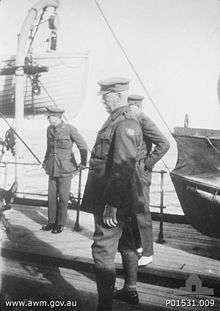Frederic Hughes
| Frederic Godfrey Hughes | |
|---|---|
 Brigadier General Frederic Hughes on board a transport ship. | |
| Born |
26 January 1858 Melbourne, Victoria |
| Died |
23 August 1944 (aged 86) St Kilda, Victoria |
| Allegiance | Australian Army |
| Years of service | 1875–1920 |
| Rank | Major General |
| Battles/wars | |
| Awards |
Companion of the Order of the Bath Mention in Despatches |
Major General Frederic Godfrey Hughes CB (26 January 1858 – 23 August 1944) was an Australian Army Major General in World War I.
Early life and career
Frederic Godfrey Hughes was born on 26 January 1858 in the Melbourne suburb of Windsor, the son of a grazier. He was educated at Melbourne Grammar School and became a clerk for a land valuer. Later he set up his own land valuation business. Hughes became involved in local politics and in 1898 was elected a St Kilda City Councillor. He served for 24 years and was Mayor of St Kilda from 1901 to 1902, and again from 1911 to 1912. He had various business interests, including directorships of Dunlop Rubber and South Broken Hill.
Hughes joined the St Kilda Artillery Battery as a driver in 1875. He became a sergeant in 1883 and was commissioned in 1885. On 20 August 1888 he was promoted to captain and took command of the Victorian Nordenfeldt Battery. Hughes was promoted to major in 1891. His battery was disbanded on 30 June 1897 and Hughes was transferred to the field artillery and became at staff officer at Headquarters in Melbourne. He was promoted to lieutenant colonel in 1900. In 1903, he was given command of the 11th Light Horse Regiment. On 6 December 1907 he was promoted to colonel and took command of the 4th Light Horse Brigade, which was renamed the 7th Light Horse Brigade in 1912. In 1909, Hughes became aide de camp to the Governor General.
World War I
Hughes was appointed to the First Australian Imperial Force as a colonel on 17 October 1914 and given command of the 3rd Light Horse Brigade. Like most militia brigadiers, Hughes was given a regular officer as a brigade major, in his case, Lieutenant Colonel John Antill. Although not an easy man to get along with, Hughes relied heavily on Antill.
The brigade departed for Egypt in February 1915 where it trained until alerted for dismounted action at Gallipoli in May. It arrived on 20 May 1915 and became part of Major General Alexander Godley's New Zealand and Australian Division. The ANZAC commander, Lieutenant General Birdwood, had grave doubts about Hughes capacity.
Godley ordered Hughes to attack the Turkish positions at the Nek at 0430 on 7 August 1915 with a bayonet charge in support of the New Zealand attack on Chunuk Bair. The attack stalled from the very beginning, when the artillery lifted some seven minutes early according to watches on Russell's Top. Then four waves of light horsemen charged the Turkish trenches at the Nek, only to be cut down.
Hughes mismanaged the battle. He left his headquarters around the time the second wave of 150 had attacked in order to try to observe the attack, thereby isolating himself from Antill and the rest of his headquarters. After the third wave had been slaughtered, Hughes gave orders for the attack to be discontinued, but not in time to save the fourth wave. He seems to have become completely rattled.
Hughes was evacuated from Gallipoli on 20 September 1915 with typhoid. He was evacuated to Australia in March 1916 suffering from typhoid and pneumonia. In July 1918, he was reappointed to the AIF and served with the Sea Transport Service. He retired in March 1920 with the rank of major general.
Post war
Hughes died in St Kilda on 23 August 1944 at age 86.
See also
References
- Ross Mallett, Frederic Godfrey Hughes, General Officers of the First AIF, adfa.edu.au - site moved
- Judy Smart, 'Hughes, Frederic Godfrey (1858 - 1944)', Australian Dictionary of Biography, Volume 9, Melbourne University Press, 1983, pp 387–388.